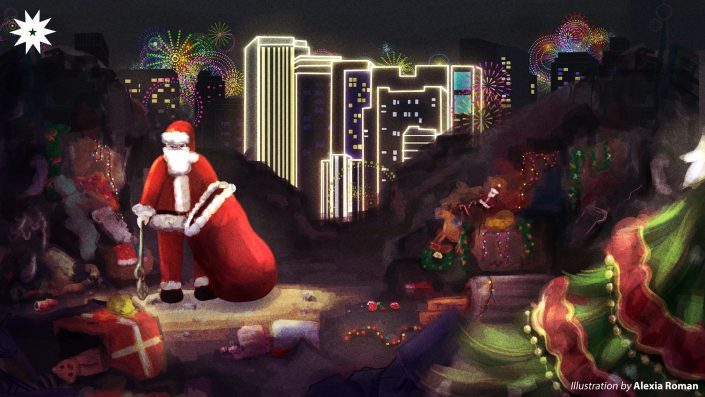Since the start of the “ber” months—the period spanning from September to December—the countdown to Christmas has begun in the Philippines. Colorful star-shaped lanterns or parols begin to line the streets, shoppers flock to purchase their Kris Kringle gifts, and malls and restaurants play Jose Mari Chan’s Christmas in Our Hearts. What started as a religious holiday has taken on commercial significance. But under the glitz of Christmas lights lies the stark reality of holiday activities as a source of pollution.

Unwrapping the problem
There is no denying the joy of unwrapping a present—or several. But after the excitement is done, the leftover boxes, ribbons, and cards often end up in landfills or waste incinerators. In the United Kingdom alone, a staggering 227,000 miles of wrapping paper are thrown away every year. These materials cannot always be recycled because many contain non-paper additives such as plastic, glitter, and gold and silver coloring.
Rappler reporter Ralf Rivas states that the recent influx of waste like face masks and gift wraps can have adverse effects on the environment, forcing local waste collectors to deploy more trucks and manpower just to dispose of the garbage. “There are just nicer or better ways to do this,” he posits.
According to Rivas, Filipinos often purchase extravagant gift wraps due to their perception that biodegradable packaging like newspapers is “taboo”. “It’s an unfortunate confluence of consumerism and lack of infrastructure that gets exposed during Christmas,” he notes. He also elaborates that with this being a hindrance to waste management, the government has to “do so much more—Christmas season or not”, given the lack of individual movement from the Filipino people.
Apart from the packaging, the gifts themselves have an impact on the environment. Manufacturing them requires money, energy, and countless raw materials. Dealing with unwanted gifts may also pose a problem. While returning these items seems like a logical solution, research by the logistics company Optoro and Environmental Capital Group has found that the shipping process for this can generate up to 16 million metric tons of carbon dioxide a year.
To address these issues, Rivas recommends giving second-hand gifts and reusing old fabrics and paper as packaging. He also believes that the stigma surrounding pre-loved items needs to be challenged. Instead of seeing them as cheap or low-quality products, people should view them as a symbol of conscious consumption.
Sustainability Scrooge
Another key element of the holidays is the food. In the Philippines, people often stay up late with friends and family for noche buena, the Christmas Eve feast. However, due to spoilage or simply too much to eat, not all of the prepared food is consumed. Some of these uneaten items are tossed in the trash, adding to the 1.6 billion tons of global food waste recorded yearly.
While food is biodegradable, it can still decompose and release methane, a greenhouse gas (GHG) that is 28 times more potent than carbon dioxide at warming the planet over a 100-year period. Worldwide, 8.2 percent of GHG emissions result from food waste alone. Much like the issue with wrapping paper, money is wasted on growing, processing, and disposing of food that is never consumed. This also puts a strain on natural resources like water, land, and labor.
Christmas has truly become synonymous with overindulgence, but this does not mean that people have to forgo these beloved traditions. While no one wants to be the Grinch, there are small steps that people can take to reduce their food waste. For instance, one could avoid overcooking by planning each meal and the number of portions they need before they buy from a store. Leftovers could also be stored or donated to the less fortunate.
Assessing the environmental costs
It cannot be Christmas without the glimmering holiday lights. As stunning and festive as they may be, these lights are proven to be a contributor to light pollution—the excessive use of artificial light which can negatively affect the health of animals and humans. This type of pollution can disrupt one’s natural body rhythm and lead to a decrease in melatonin levels—resulting in health problems like fatigue, stress, and sleep deprivation. It can also negatively alter the nighttime environment of nocturnal wildlife, confusing their circadian rhythms or the behavioral, mental, and physical changes that occur to humans within a 24-hour time frame.
In fact, a study published by the University of York states that 5.5 percent of yearly GHG emissions are due to Christmas lights. Their incandescent bulb composition has altered light intensity patterns during the nighttime, allowing astronauts to “identify if it’s Christmas from outer space”.
Christmas trees, in addition, are also a major factor in the pollution that the holiday season brings. While real Christmas trees are biodegradable and have no negative environmental impact, the use of fertilizers and pesticides for efficient tree growth is deemed detrimental to ecosystems due to their excessive GHG emissions.
Rethinking the holiday aftermath
While Christmas is the season of joy and giving, a certain level of responsibility still has to be upheld during the merrymaking—and that starts with proper waste disposal and the usage of more environmentally-friendly decorations. To add to that, a lot of thought should be put into gifts before buying them; otherwise, as Rivas said, it will just end up as “[more] waste in the house”.
Christmas can still be enjoyed without neglecting the environment in the process. As Rivas establishes, “When the holiday season ends, it’s still us [who are] going to clean [the mess] up and suffer the consequences.”
